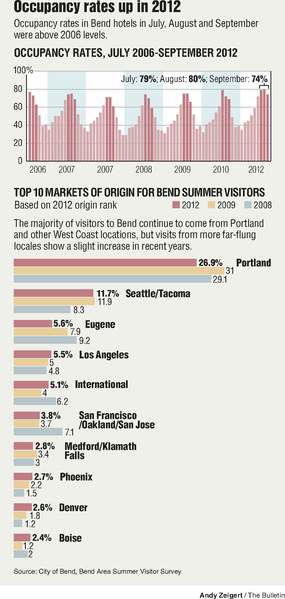Tourism on the rise
Published 4:00 am Monday, December 3, 2012

- Tourism on the rise
Bend has earned titles like Dogtown USA and one of America’s best ski towns. It’s home to the brewery that produces the World’s Best Beer. So it’s no wonder tourism is on the rise in Bend and Central Oregon.
Tourism, one of the region’s economic anchors, is returning close to pre-recession levels, according to economic and tourism experts.
Trending
“Tourism is critically important for the health of Bend’s economy,” said Doug La Placa, CEO and president of Visit Bend — the city’s tourism agency. “It generates approximately half a billion dollars annually for our region and impacts virtually every segment of our economy. Not only does tourism generate an immediate economic impact through direct visitor spending, but perhaps more important, tourism serves as the primary catalyst for in-migration of new residents and new jobs.”
Tourism has been rebounding for the last couple of years, said University of Oregon economist Tim Duy, the author of the University of Oregon Central Oregon Business Index.
“Estimated lodging revenue, adjusted for inflation, gained for the third consecutive quarter, reaching its highest level since the third quarter (July-September) of 2007,” according to the index of economic indicators released Sunday.
When adjusted for inflation, Duy said tourism has returned to levels last seen prior to the recession. This year’s third quarter lodging revenue totaled $1.6 million, nearly reaching 2007’s high of $1.63 million.
Along with lodging revenue, room tax collection for the city of Bend and Deschutes County also increased during the third quarter, according to data from Visit Bend and Central Oregon Visitors Association — the regional tourism agency.
Bend had the most room-tax collection in history this summer, La Placa said. In addition, he said citywide lodging occupancy during the 2012 fiscal year set a record high, exceeding 54 percent for the first time.
Trending
The majority of visitors are coming from Oregon, especially Portland, followed by Washington and California, based on the Bend Area Summer Visitor Survey. However, there have also been slight increases in visits from across the country and internationally since summer 2009, the survey shows.
Renita Patel, a 25-year-old Portland resident, said she came to Bend to escape the city for a night.
“Bend is just a really nice place to relax,” she said Saturday while leaving The Oxford Hotel. “It’s nestled in the mountains, it’s really gorgeous out here and it’s very welcoming to tourists.”
While vacationing closer to home has become a more popular trend, La Placa said it’s critical to continue to introduce Bend to new consumers and attract investment from larger economies outside the Pacific Northwest.
This year both Visit Bend and COVA launched aggressive regional and national advertising campaigns to drive tourism to Bend and the region.
“I believe the Bend tourism industry is positioned strongly for long-term growth,” La Placa said. “If we can continue to diversify our tourism offerings, continue to evolve our amenities, and more aggressively introduce our destination to new customers, I have no doubt that Bend’s extraordinary appeal will sustain long-term growth.”
While Central Oregon tourism rebounded over the summer months, Alana Hughson, president and CEO of COVA, said the upswing might not continue.
Advertising and public relations is effectively positioning the region, she said, but national economic stability will impact tourism locally and nationwide.
Hughson said Central Oregon experienced a slowdown of business in October and November, but she noted the room tax reports that help indicate tourism aren’t yet available for those months.
“The late-fall slowdown indicates that a ‘robust’ recovery is too optimistic and we may see things fall off quite a bit over the winter months,” she wrote in an email. “The state of the national domestic economy may have a big influence on travel trends through the winter and the conjecture about the ramifications of the ‘fiscal cliff’ appear to be impacting travel in a less-than-favorable way.”








